Immerse yourself in the enchanting Monkey Forest Ubud, a sanctuary where nature, spirituality, and human interaction intertwine. This sacred forest, revered by locals and cherished by visitors, offers a captivating glimpse into the harmonious coexistence of wildlife and Balinese traditions.
Within the verdant embrace of the forest, playful macaques roam freely, their antics providing endless entertainment. As you venture deeper, discover the profound connection between these primates and the local culture, where they are revered as sacred beings.
Introduction
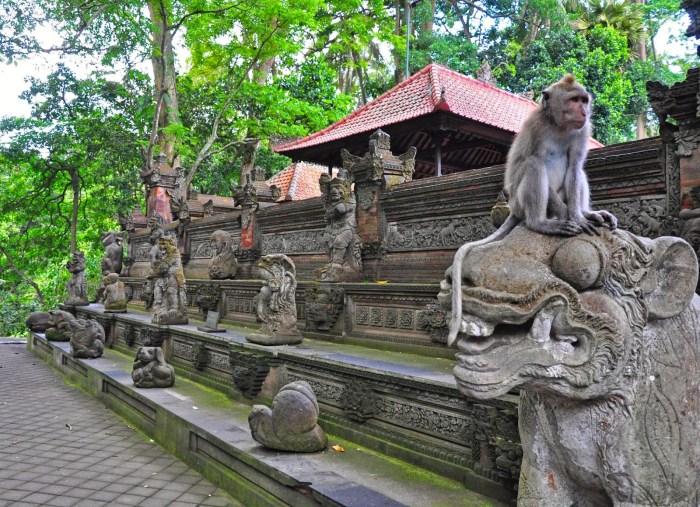
The Monkey Forest in Ubud, Bali, is a captivating natural and cultural destination. It’s a sanctuary for the long-tailed macaque, a revered species in Balinese tradition. The forest’s sacred status and rich biodiversity make it a significant site for locals and visitors alike.
The Monkey Forest Ubud is a popular tourist destination in Bali. If you’re looking for a place to exchange currency near the forest, there are several money changers located within walking distance. After exchanging your currency, you can head back to the Monkey Forest Ubud and enjoy the sights and sounds of the forest.
Significance
The Monkey Forest holds profound cultural and spiritual importance. The macaques are believed to be the descendants of a holy figure, and their presence is seen as a blessing. The forest is protected as a sacred area, where traditional ceremonies and rituals are performed.
Its lush vegetation and diverse wildlife further enhance its spiritual significance, creating a harmonious balance between nature and spirituality.
History and Cultural Importance: Monkey Forest Ubud
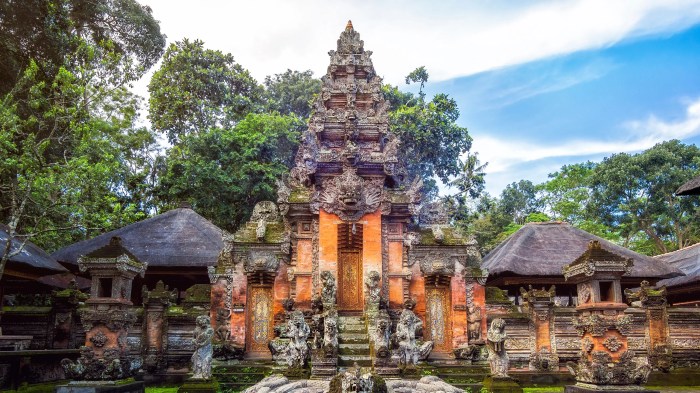
The Monkey Forest in Ubud, Bali, holds deep historical and cultural significance within the Balinese Hindu community. Its origins can be traced back to the 14th century, during the reign of King Waturenggong.
According to local legend, the king established a temple called Pura Dalem Agung Padangtegal in the forest. The temple became a sacred site for the local villagers, and the monkeys were believed to be the guardians of the temple and its surrounding area.
Role of the Monkeys in Local Beliefs and Traditions
The monkeys in the Monkey Forest are considered to be sacred animals and are revered by the Balinese people. They are believed to be the descendants of the monkey god, Hanuman, who is an important figure in the Hindu epic Ramayana.
- Protection:The monkeys are believed to protect the temple and its surroundings from evil spirits and other threats.
- Fertility:The monkeys are also associated with fertility and are believed to bring good luck to those who visit the forest.
- Healing:Some Balinese people believe that the monkeys possess healing powers and that their saliva can cure certain illnesses.
Biodiversity and Conservation
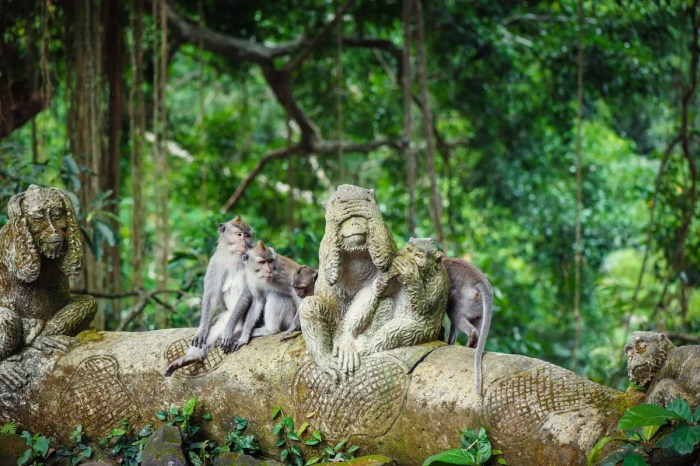
The Monkey Forest is home to a diverse range of flora and fauna. The forest is dominated by tropical trees, including banyan, strangler fig, and kapok trees. These trees provide food and shelter for a variety of animals, including monkeys, bats, birds, reptiles, and amphibians.
The most famous inhabitants of the Monkey Forest are the long-tailed macaques. These monkeys are highly social and live in large groups. They are known for their playful and curious nature, but they can also be aggressive if they feel threatened.
Conservation Efforts
The Monkey Forest is a protected area, and several conservation efforts are in place to protect the forest and its inhabitants. These efforts include:
- Restricting access to the forest
- Educating visitors about the importance of conservation
- Monitoring the monkey population
- Rehabilitating injured or orphaned monkeys
These efforts have helped to ensure that the Monkey Forest remains a thriving ecosystem for both humans and animals.
Monkey Behavior and Interactions

The Monkey Forest of Ubud is home to several species of monkeys, each with unique characteristics and behaviors. Understanding their social structure, feeding habits, and proper interaction guidelines ensures a safe and enjoyable experience for both visitors and the monkeys.
A trip to the Monkey Forest in Ubud, Bali is an unforgettable experience. With its lush greenery and playful monkeys, it’s a must-visit for nature lovers. While planning your trip to Bali, don’t forget to book a comfortable singapore hotel for a relaxing stay.
After exploring the Monkey Forest, consider extending your adventure with a visit to Singapore, where you can immerse yourself in a vibrant blend of cultures and modern attractions.
Monkey Species
- Long-tailed Macaque:The most common species, known for its distinctive long tail and playful nature.
- Balinese Long-tailed Macaque:A subspecies endemic to Bali, with a darker coat and a more solitary lifestyle.
- Crab-eating Macaque:Smaller in size, with a distinctive reddish-brown coat and a diet that includes crabs and shellfish.
Social Structure and Behavior, Monkey forest ubud
Monkeys in the forest live in complex social groups with a hierarchical structure. Dominant males lead the group, while females and younger individuals occupy lower ranks. They communicate through vocalizations, body language, and facial expressions.
- Grooming:Monkeys spend significant time grooming each other to strengthen social bonds and maintain hygiene.
- Play:Young monkeys engage in playful behavior, which is essential for their physical and social development.
- Territoriality:Groups defend their territories from other groups through vocalizations and displays of aggression.
Feeding Habits
Monkeys in the Monkey Forest are omnivorous, with a diet that includes fruits, leaves, insects, and small animals. They are opportunistic feeders and will consume whatever is available.
Responsible Interactions
- Respect their space:Do not approach or touch the monkeys, as this can cause stress or aggression.
- Avoid feeding:Monkeys should not be fed by visitors, as this can disrupt their natural feeding habits and lead to health problems.
- Be aware of your belongings:Monkeys are known to snatch food, sunglasses, and other small items, so be vigilant and keep your valuables close.
Tourism and Sustainable Practices
The Monkey Forest has become a popular tourist destination, attracting thousands of visitors each year. While tourism can provide economic benefits, it also brings challenges in terms of managing the impact on the wildlife and their habitat.
The Monkey Forest Ubud is a must-visit destination in Bali, offering an unforgettable experience of interacting with hundreds of playful monkeys. While you’re in the area, don’t miss the chance to explore the nearby pura lempuyang , an iconic temple with stunning views of Mount Agung.
After your spiritual journey at pura lempuyang, return to the Monkey Forest Ubud for a delightful stroll through its lush greenery, where you can observe the monkeys in their natural habitat.
To ensure sustainable practices and minimize disturbance to the monkeys, the following measures have been implemented:
Visitor Guidelines
- Visitors are required to follow strict guidelines, such as maintaining a respectful distance from the monkeys, not feeding them, and avoiding loud noises or sudden movements.
- Guided tours are available to provide visitors with information about the monkeys and their behavior, promoting responsible interactions.
Habitat Management
- The forest is well-maintained, providing a suitable habitat for the monkeys, including a variety of trees for foraging and shelter.
- Natural food sources are supplemented during lean seasons to ensure the monkeys’ nutritional needs are met.
Research and Monitoring
- Ongoing research and monitoring programs help to track the monkeys’ population, health, and behavior.
- This information is used to inform management practices and ensure the long-term well-being of the monkeys.
Artistic Representations
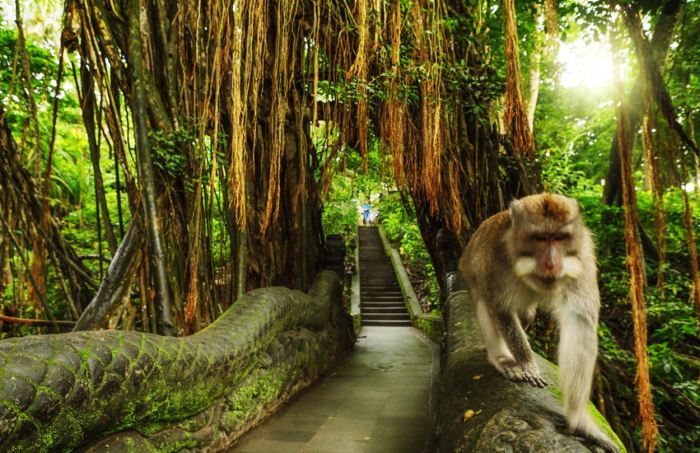
The Monkey Forest in Ubud has inspired countless works of art, photography, and literature, capturing its enchanting beauty and unique wildlife. These artistic representations have played a significant role in showcasing the forest’s cultural significance and ecological importance.
In painting and photography, the monkeys themselves are often the central subjects, depicted in their playful and curious nature. Artists have used various techniques to capture the forest’s lush vegetation, vibrant colors, and serene atmosphere. Notable artworks include paintings by Balinese artist I Gusti Nyoman Lempad and photographs by wildlife photographer Frans Lanting.
Literature
The Monkey Forest has also found its way into the realm of literature. Balinese writer I Wayan Warna’s novel “The Monkeys of Ubud” explores the relationship between humans and monkeys in the forest. International authors such as Elizabeth Gilbert and Julia Roberts have written about their experiences visiting the forest in their travel memoirs.
Educational and Research Opportunities

The Monkey Forest of Ubud provides a unique platform for educational programs and research activities. It has established partnerships with universities and research institutions worldwide to facilitate the study of monkey behavior, conservation, and the human-monkey interface.
Educational programs at the Monkey Forest include guided tours, lectures, and workshops. These programs aim to educate visitors about the ecology, behavior, and conservation of monkeys. They also highlight the importance of protecting the forest and its inhabitants.
Research Activities
- Behavioral Studies:Researchers conduct long-term observations to study the social behavior, communication, and reproductive patterns of the monkeys.
- Conservation Genetics:Genetic studies help understand the population structure, genetic diversity, and potential threats to the monkey population.
- Disease Monitoring:Regular health checks and disease surveillance are conducted to monitor the health status of the monkeys and prevent disease outbreaks.
- Human-Monkey Interactions:Researchers investigate the interactions between tourists and monkeys, aiming to develop strategies for minimizing conflicts and promoting responsible tourism.
These research activities have contributed significantly to our understanding of monkey behavior and conservation. The findings have been published in peer-reviewed journals and presented at international conferences, informing conservation strategies and raising awareness about the importance of protecting these animals.
Tips for Visitors
Planning a visit to the Monkey Forest in Ubud? Here are some practical tips to ensure a safe, respectful, and enjoyable experience:
To minimize disruption to the monkeys and preserve their natural habitat, follow these guidelines:
Recommended Times to Visit
Visit during the morning or late afternoon when the monkeys are most active and less likely to be napping.
Dress Code
- Wear comfortable, modest clothing that covers your knees and shoulders.
- Avoid bright colors or loose clothing that may attract the monkeys’ attention.
Safety Precautions
- Keep your distance from the monkeys and avoid sudden movements.
- Do not feed or touch the monkeys, as this can disrupt their natural behavior and pose a safety hazard.
- Be aware of your surroundings and keep your belongings secure.
- Follow the instructions of the park rangers and respect the designated paths.
Respecting the Monkeys
- Observe the monkeys from a distance and avoid making loud noises or disturbing their natural behavior.
- Do not litter or leave food wrappers in the forest, as this can attract pests and harm the monkeys.
- Respect the monkeys’ space and do not attempt to pet or interact with them.
Conclusive Thoughts
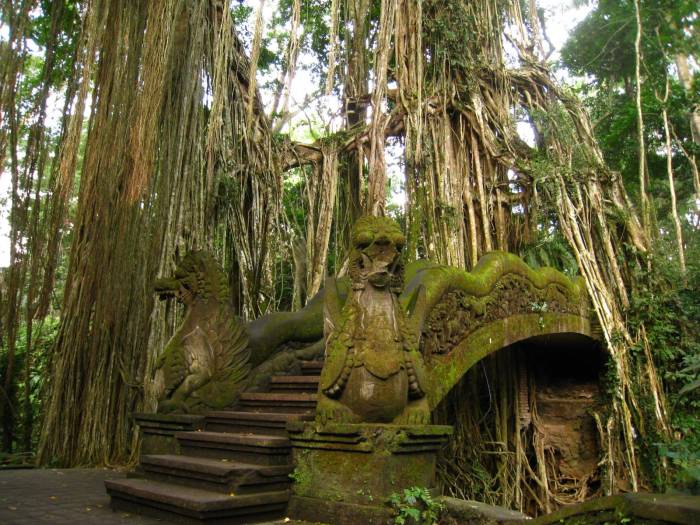
As you bid farewell to the Monkey Forest Ubud, its allure lingers in your heart. This unique sanctuary serves as a testament to the delicate balance between nature and culture, reminding us of the importance of preserving our shared heritage for generations to come.
Question Bank
Is it safe to interact with the monkeys?
While the monkeys are generally friendly, it’s important to maintain a respectful distance and avoid feeding or touching them.
What is the best time to visit the Monkey Forest?
Early morning or late afternoon is ideal, as the monkeys are most active during these times.
Is there a dress code for visiting the Monkey Forest?
Yes, it’s recommended to dress modestly and cover your shoulders and knees.